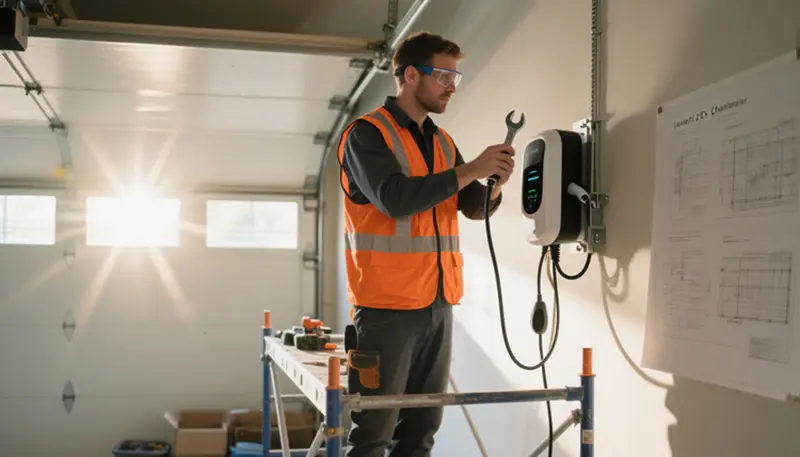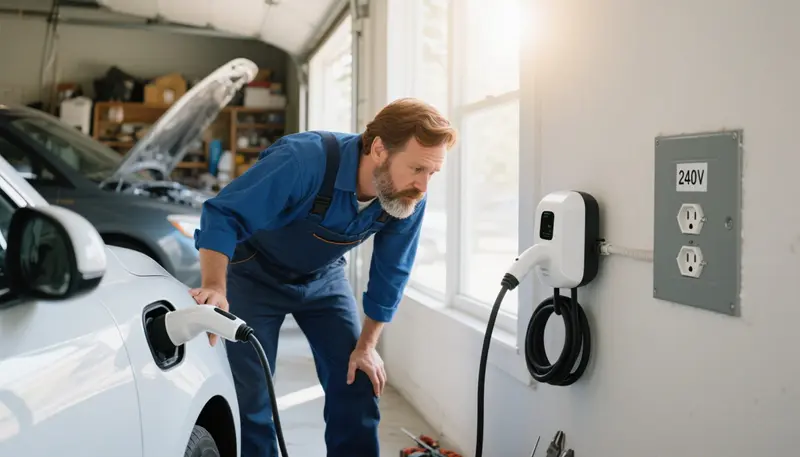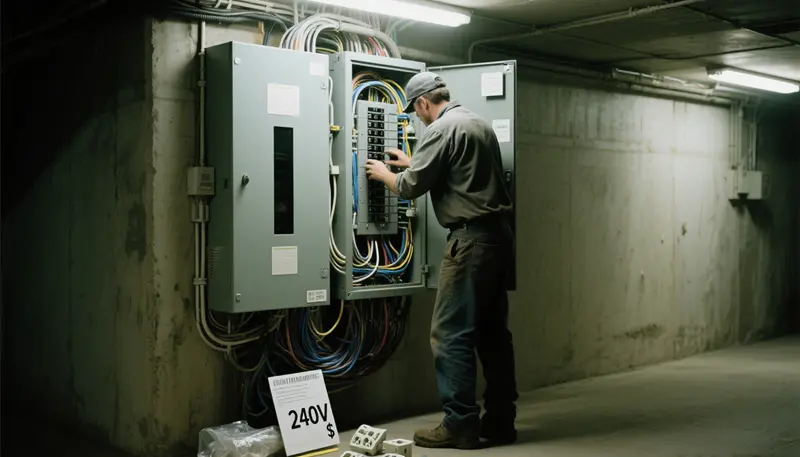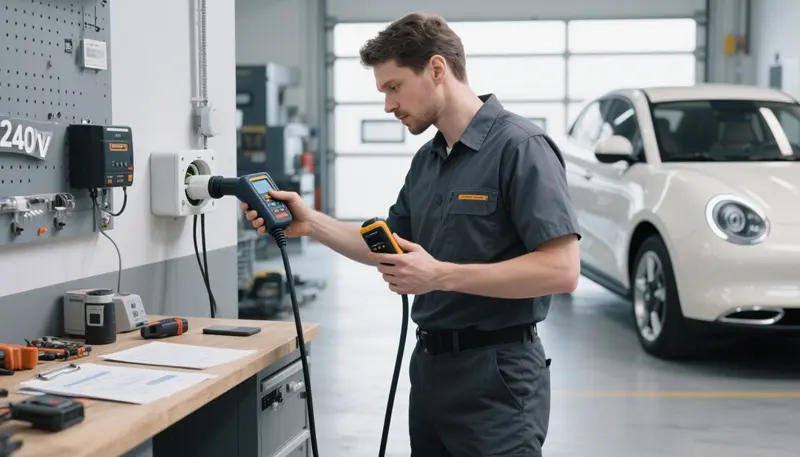Blog
Best Location for EV Charger in Garage: Installation Guide
Introduction to EV Charger Installation in Your Garage
As electric vehicles (EVs) continue to gain traction across the U.S. and Europe, home charging solutions are becoming essential for EV owners. Among the most popular and practical locations for installing an EV charger is the garage, offering protection from the elements, proximity to electrical systems, and convenience for daily use. But what is the best location for an EV charger in a garage? Can an electric car charger be installed in a garage, and if so, where to install an EV charger in a garage to maximize efficiency and safety? This comprehensive guide answers these questions, providing expert insights on choosing the optimal spot for an EV charger in a garage, along with installation steps, costs, and considerations for a seamless setup.
This article explores the factors that determine the best location for an EV charger in a garage, addressing can an electric car charger be installed in a garage and offering practical advice on where to install an EV charger in a garage. Whether you’re a Tesla owner, a Nissan Leaf driver, or preparing for a future EV, this guide will help you plan a safe, efficient, and cost-effective EV charger in a garage installation.
Why Choose a Garage for Your EV Charger?
The Advantages of Garage-Based Charging
The garage is often the ideal location for an EV charger in a garage due to its unique benefits:
- Protection from Weather: A garage shields the charger from rain, snow, and extreme temperatures, extending equipment lifespan and ensuring reliable operation.
- Proximity to Electrical Systems: Most home electrical panels are located in or near the garage, reducing wiring costs and simplifying installation.
- Convenience: Parking your EV in the garage makes it easy to plug in, especially for daily charging routines.
- Safety and Security: A garage offers a secure, enclosed space, reducing the risk of vandalism or theft of the charger or cable.
- Aesthetic Appeal: Installing an EV charger in a garage keeps your home’s exterior clean and uncluttered, appealing to homeowners in HOAs or urban areas.
Can an Electric Car Charger Be Installed in a Garage?
The answer to can an electric car charger be installed in a garage is a resounding yes. Garages are well-suited for both Level 1 (120V) and Level 2 (240V) chargers, accommodating a wide range of EVs, including Tesla, Ford Mustang Mach-E, and Rivian models. Level 2 chargers, which require a 240V circuit, are the most common choice for garage installations due to their faster charging speeds (20-50 miles of range per hour). However, choosing the best location for an EV charger in a garage requires careful planning to optimize functionality, safety, and cost.
Why Location Matters
Selecting where to install an EV charger in a garage impacts usability, installation costs, and safety. A poorly chosen location can lead to inconvenient cable management, increased wiring expenses, or safety hazards like tripping or overheating. By identifying the best location for an EV charger in a garage, you can ensure a seamless charging experience tailored to your needs.
Determining the Best Location for an EV Charger in a Garage
Key Factors for Choosing the Best Location
To find the best location for an EV charger in a garage, consider the following factors:
Proximity to Parking Area:
- Place the charger near where your EV is parked to minimize cable length (typically 5-7.5 meters for most chargers).
- Ensure the cable can reach the vehicle’s charging port without stretching or creating tripping hazards.
- For multi-car garages, position the charger to serve multiple vehicles, if needed.
Proximity to Electrical Panel:
- Installing near the electrical panel reduces wiring costs, which can account for 30-50% of the EV charger in a garage installation cost.
- A charger within 10-20 feet of the panel typically costs $400-$800, compared to $1,000-$2,000 for longer runs.
Ventilation and Heat Management:
- Ensure the charger is in a well-ventilated area to prevent overheating, especially for Level 2 chargers generating heat during operation.
- Avoid placing the charger near heat sources (e.g., water heaters) or in tightly enclosed spaces.
Space and Accessibility:
- Choose a location that doesn’t obstruct garage doors, storage areas, or walkways.
- Wall-mounted chargers save floor space, while pedestal mounts may suit larger garages.
- Ensure compliance with accessibility standards (e.g., ADA in the U.S.) if the charger is shared in a multi-family setting.
Safety Considerations:
- Position the charger away from flammable materials (e.g., gasoline, paint) to comply with fire codes.
- Use a weatherproof enclosure (e.g., NEMA 3R、IP65) if the garage is exposed to moisture or dust.
Optimal Locations in Different Garage Types
- Single-Car Garage:
- Best Location for EV Charger in Garage: Near the vehicle’s charging port (typically front or rear) on a wall adjacent to the parking spot.
- Example: Mount a Tesla Wall Connector on the wall closest to the car’s rear port, within 5 feet of the panel.
- Double-Car Garage:
- Where to Install EV Charger in Garage: Centrally between parking spaces or on a shared wall to serve multiple EVs.
- Example: Install a dual-port charger to accommodate two vehicles.
- Garage with Storage or Workshop:
- Best Location for EV Charger in Garage: On a wall near the parking area but away from storage shelves or tools to avoid clutter.
- Example: Mount the charger on a corner wall with a cable management system to keep the area tidy.
Practical Tips for Choosing Where to Install
- Measure Cable Reach: Ensure the charger’s cable (5-7.5 meters for most models) reaches the EV’s port comfortably.
- Plan for Future EVs: Choose a location that can accommodate additional chargers if you plan to own multiple EVs.
- Consult Your Electrician: A professional can assess your garage layout and electrical capacity to recommend the best location for an EV charger in a garage.
By carefully evaluating these factors, you can determine where to install an EV charger in a garage to balance convenience, cost, and safety.
Steps to Install an EV Charger in a Garage
Assess Your Electrical System
Before installing an EV charger in a garage, have a licensed electrician evaluate:
- Panel Capacity: Most homes have 100 amp panels. A Level 2 charger requires a 40-50 amp circuit, which may necessitate a panel upgrade ($1,000-$3,000).
- Load Calculation: Ensure the circuit won’t overload other appliances (e.g., dryer, HVAC).
- Proximity to Panel: A charger near the panel reduces wiring costs, making it a best location for an EV charger in a garage.
Choose the Charger Type
- Level 1 Charger (120V):
- Plugs into a standard outlet (e.g., NEMA 5-15), delivering 3-5 miles of range per hour.
- Ideal for plug-in hybrids or low-mileage EVs.
- No permit or major electrical work needed if using an existing outlet.
- Level 2 Charger (240V):
- Requires a dedicated 240V circuit (e.g., NEMA 14-50 or hardwired).
- Delivers 20-50 miles of range per hour, suitable for most EVs.
- Common choice for EV charger in a garage installations (e.g.,👉 FlagTools Home EV Charger).
Select the Installation Method
- Wall-Mounted: Ideal for space-constrained garages, mounted 3-5 feet above the floor for easy access.
- Pedestal-Mounted: Suitable for larger garages, placed centrally to serve multiple vehicles.
- Cable Management: Use retractable reels or hooks to keep cables organized and prevent tripping.
Hire a Licensed Electrician
- Why Professional Installation? Installing a 240V EV charger in a garage involves high-voltage wiring, posing risks if done incorrectly. A licensed electrician ensures compliance with the National Electrical Code (NEC) Article 625 or IEC 61851 standards.
- Tasks:
- Run 6 AWG copper or 4 AWG aluminum wiring from the panel to the charger location.
- Install a 40-50 amp double-pole breaker.
- Mount the charger or outlet (e.g., NEMA 14-50) in the best location for an EV charger in a garage.
- Secure necessary permits ($50-$200).
Obtain Permits
- Most jurisdictions require a permit for Level 2 EV charger in a garage installations due to the new 240V circuit.
- Your electrician typically handles the permit application, submitting plans to the local building department.
- Learn more about 👉“How to Apply for a Permit to Install an EV Charger”
- Post-installation inspections ensure compliance with safety standards.
Test and Finalize
- Test the charger to ensure it delivers the correct voltage and communicates with your EV.
- Organize cables to maintain a tidy garage and prevent hazards.
- Retain permit documentation for insurance or warranty purposes.
By following these steps, you can ensure a safe and efficient EV charger in a garage installation, optimized for your chosen location.
Factors Influencing the Best Location for an EV Charger in a Garage
1. Parking Habits
- Vehicle Placement: Consider where your EV’s charging port is located (e.g., front for Tesla Model 3, rear for Nissan Leaf) when choosing where to install an EV charger in a garage.
- Cable Length: Most chargers have 5-7.5 meter cables, sufficient for most garages but requiring careful placement for corner parking or tight spaces.
- Multi-Vehicle Setup: For households with multiple EVs, position the charger centrally or install multiple units to serve all vehicles.
2. Electrical Panel Location
- Cost Impact: Installing near the panel minimizes wiring costs, which can range from $100-$500 for short runs to $1,000-$2,000 for longer ones.
- Panel Capacity: Older homes with 100-amp panels may require upgrades ($1,000-$3,000) to support a 240V EV charger in a garage.
- Subpanel Option: If the main panel is distant, a subpanel ($500-$1,500) near the best location for an EV charger in a garage can reduce costs.
3. Space Constraints
- Garage Layout: Avoid obstructing garage doors, walkways, or storage areas when selecting where to install an EV charger in a garage.
- Wall vs. Pedestal: Wall-mounted chargers save space in small garages, while pedestals suit larger or multi-car setups.
- Storage Integration: Ensure the charger doesn’t interfere with shelves, bikes, or tools.
4. Safety and Compliance
- Fire Safety: Place the charger away from flammable materials (e.g., gasoline cans, paint) to comply with fire codes.
- Ventilation: Ensure adequate airflow to prevent overheating, especially in unventilated garages.
- Code Compliance: Adhere to NEC Article 625 (U.S.) or IEC 61851 (Europe) for safe EV charger in a garage installations.
5. Accessibility and Convenience
- Ease of Use: Position the charger at a height (3-5 feet) and location for easy plug-in and unplugging.
- Cable Management: Use hooks, reels, or wall-mounted holders to keep cables tidy and prevent tripping.
- Future-Proofing: Choose a location that can accommodate additional chargers or higher-power units for future EVs.
By balancing these factors, you can identify the best location for an EV charger in a garage that optimizes convenience, safety, and cost.
Costs and Considerations for EV Charger Installation in a Garage
Cost Breakdown
The cost to install an EV charger in a garage varies based on charger type, location, and electrical requirements:
Equipment Costs:
- Level 1 Charger: $100-$300 (often included with the EV).
- Level 2 Charger: $300-$1,200 (e.g.,👉 FlagTools Home EV Charger).
- Outlet (if needed): $10-$50 (e.g., NEMA 14-50 or 6-50).
- Wiring and Conduit: $50-$200, depending on distance to the panel.
Labor Costs:
- Electrician fees: $300-$1,500, based on hourly rates ($50-$150 in the U.S., €40-€100 in Europe) and installation complexity.
- Simple installations (near panel): 2-4 hours.
- Complex setups (long wiring runs): 6-8 hours.
Electrical Upgrades:
- Panel Upgrade: $1,000-$3,000 if upgrading from 100 to 200 amps.
- Subpanel: $500-$1,500 for distant installations.
- Service Upgrade: $2,000-$5,000 (rare for Level 2 chargers).
Permits and Inspections:
- Permit fees: $50-$200.
- Inspection fees: $50-$150.
Total Cost Range:
- Level 1 Charger: $100-$500 (using existing outlet).
- Level 2 Charger (Simple): $400-$1,000 (near panel, no upgrades).
- Level 2 Charger (Average): $800-$2,000 (moderate wiring).
- Level 2 Charger (Complex): $2,000-$5,000 (panel upgrades, long runs).
Cost-Saving Tips
- Choose the Best Location: Installing near the panel reduces wiring costs, making it the best location for an EV charger in a garage.
- Leverage Incentives: U.S. federal tax credits (30% up to $1,000) and state rebates (e.g., California’s $500 CALeVIP) can offset costs. In Europe, UK’s EVHS (£350) or Germany’s KfW (€900) grants apply.
- Compare Quotes: Get 3-5 electrician quotes to find the best price for EV charger in a garage installation.
- Use Existing Outlets: For Level 1 chargers, an existing 120V outlet eliminates installation costs.
Safety Considerations
- Ventilation: Ensure the EV charger in a garage is in a well-ventilated area to prevent heat buildup.
- Fire Safety: Keep the charger away from flammable materials and ensure compliance with fire codes (e.g., NFPA 70).
- Weatherproofing: If the garage is exposed to moisture, use a NEMA 3R enclosure for outdoor-rated chargers.
- Professional Installation: Always hire a licensed electrician to ensure a safe EV charger in a garage setup.
Frequently Asked Questions (FAQ)
Q: Can an electric car charger be installed in a garage?
A: Yes, an electric car charger can be installed in a garage, making it an ideal location due to protection from weather, proximity to the electrical panel, and convenience. Both Level 1 and Level 2 chargers are suitable.
Q: What is the best location for an EV charger in a garage?
A: The best location for an EV charger in a garage is near the vehicle’s parking spot, close to the electrical panel, and in a well-ventilated, accessible area. Wall-mounted chargers near the car’s charging port are often ideal.
Q: Where to install an EV charger in a garage?
A: Where to install an EV charger in a garage depends on your parking habits, panel location, and space constraints. Choose a spot near the EV’s charging port, within 10-20 feet of the panel, and away from obstructions.
Q: How much does it cost to install an EV charger in a garage?
A: Costs range from $400-$2,000 for a Level 2 EV charger in a garage, including equipment ($300-$1,200), labor ($300-$1,500), and permits ($50-$200). Complex setups with panel upgrades can reach $2,000-$5,000.
Q: Do I need a permit for an EV charger in a garage?
A: Yes, most jurisdictions require a permit for Level 2 EV charger in a garage installations due to the 240V circuit. Permits cost $50-$200, handled by your electrician.
Q: How do I manage cables for an EV charger in a garage?
A: Use cable management solutions like retractable reels, wall hooks, or charger docks to keep cables tidy and prevent tripping in the best location for an EV charger in a garage.
Conclusion: Find the Best Location for Your EV Charger in a Garage
Choosing the best location for an EV charger in a garage is a critical step in creating an efficient, safe, and convenient home charging setup. By installing an EV charger in a garage near the parking area and electrical panel, you can minimize costs, enhance usability, and ensure compliance with safety standards. Whether you’re wondering can an electric car charger be installed in a garage or seeking guidance on where to install an EV charger in a garage, working with a licensed electrician and following local codes will guarantee a successful installation.








